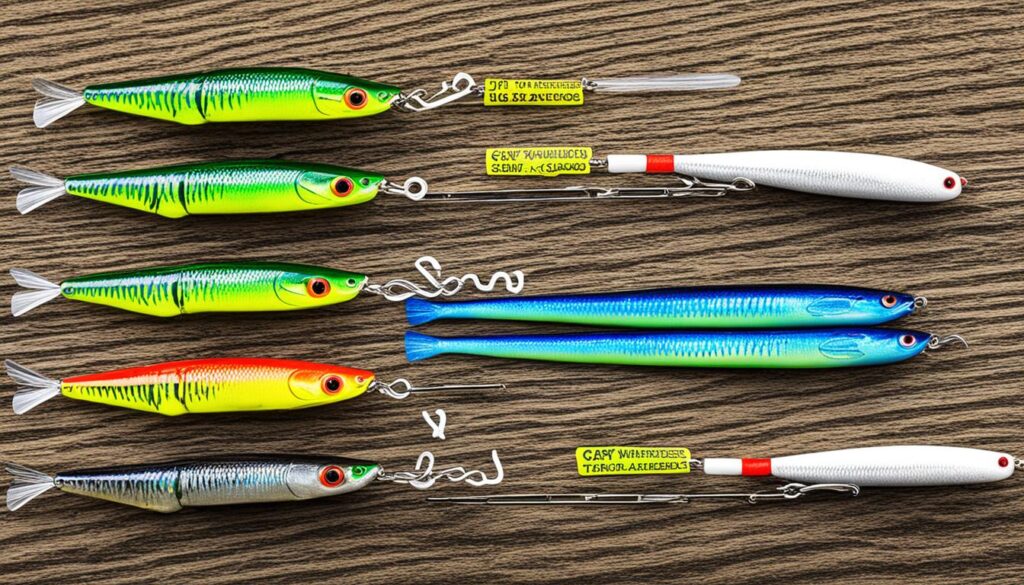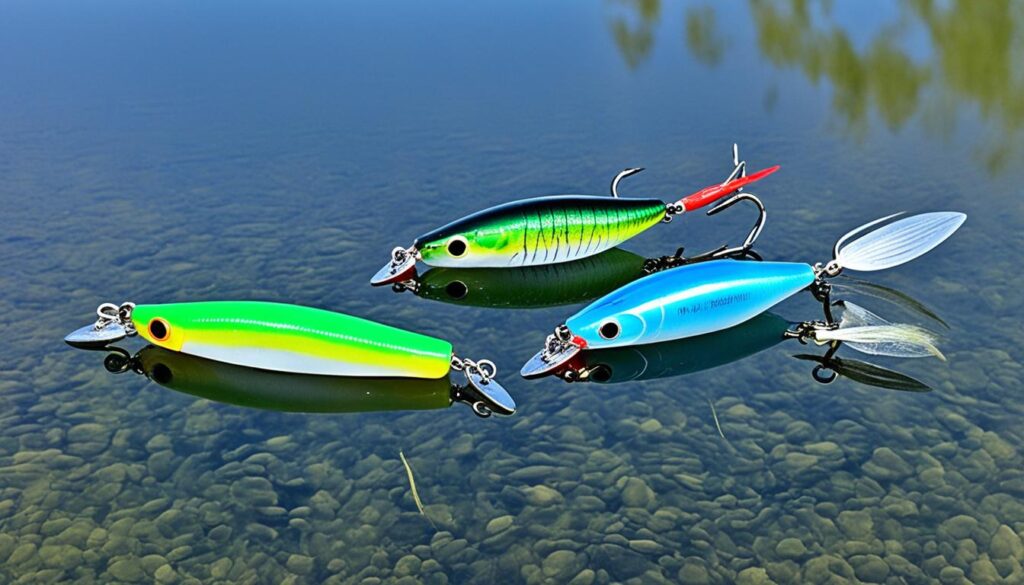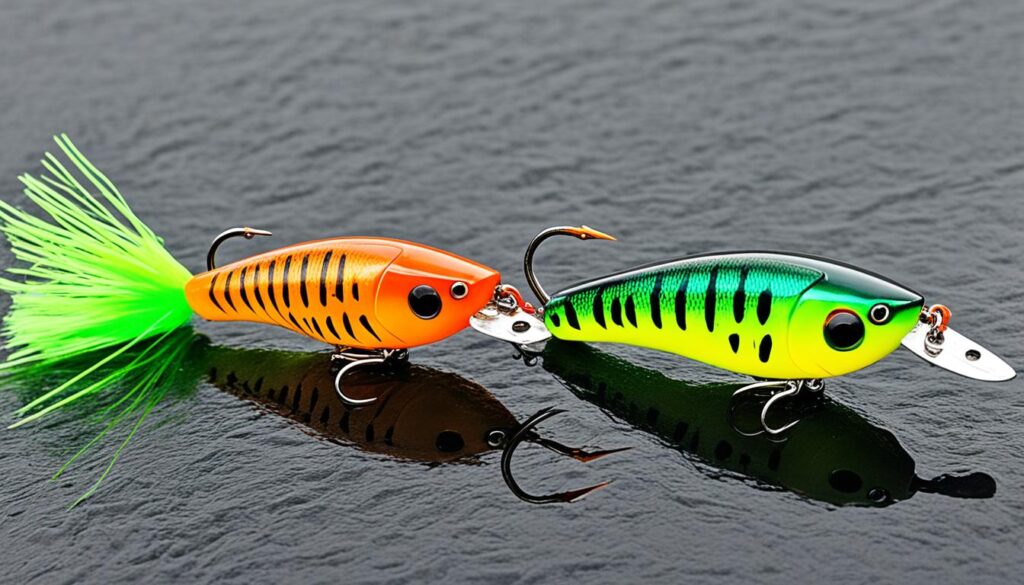Welcome to the ultimate showdown of two leading stick baits: dinger vs Senko. As a dedicated angler, I know choosing the right bait is crucial for fishing success and managing costs. The Yum Dinger and the Gary Yamamoto Senko are popular among anglers due to their unique features. We will examine the differences to help you decide which stick bait is best for you.
Key Takeaways:
- The YUM Dinger and Gary Yamamoto Senko are highly regarded stick baits in the fishing community.
- Both baits offer unique characteristics that cater to different fishing techniques and conditions.
- The price difference between the two baits makes the YUM Dinger a more affordable option.
- Buoyancy is a crucial factor when choosing between the two baits.
- Understanding the differences and similarities between the YUM Dinger and Gary Yamamoto Senko will help you make an informed decision.
dinger vs senko showdown
The dinger vs senko each offers unique characteristics and performance. The Senko, for example, is heavier and has a softer texture due to its salt impregnation, which gives it a lifelike movement in water but can make it seem less durable. In contrast, the Dinger is lighter, smoother, and not salt-impregnated, which affects its sinking speed and casting distance but enhances its durability and cost-effectiveness. It also features a forktail design and hook channel for added versatility, allowing it to be used in various fishing techniques and conditions.
While I prefer the Senko for its realistic action, I also see the value in keeping Dingers for their longevity and lower cost. Despite being lighter, extensive testing has shown that the Dinger effectively attracts fish, proving its worth in various fishing conditions. Its combination of price, performance, and the ability to consistently attract game fish like Mr. Bass makes it a compelling choice for anglers.
Ultimately, the choice between these baits depends on specific fishing needs and preferences. The Senko excels at mimicking natural prey, while the Dinger offers practical benefits and consistent effectiveness.
“The Senko’s heavier weight lets it sink quickly in deep water or fast currents,” explains fishing expert Mark Thompson. “The Dinger’s smoothness helps it wiggle more and smell better. This is key in tough fishing spots.”
Some might worry the Senko will only last for a while because it’s soft. Many anglers like how easy it is for a hook to get through, which means more chances to catch fish. The Dinger can handle more bites without falling apart, which is suitable for extended fishing trips.
Comparing Physical Characteristics
Let’s look closer at the Yum Dinger vs Yamamoto Senko to see how they differ:
Advantages of YUM Dinger:
- Enhanced durability
- More cost-effective
- Wide range of colors
- Available forktail design
Disadvantages of YUM Dinger:
- Not salt-impregnated
Gary Yamamoto Senko: Soft and Salt-Infused
The Yamamoto Senko is softer to the touch and has a unique feature: it is salt-impregnated. This means that the salt is integrated into the bait, enhancing its flavor and making it more attractive to fish. The Senko differs from the YUM Dinger’s external salt coating, which can wash off after several casts. However, due to their softer construction, Senkos tend to be less durable.
Advantages of Yamamoto Senko:
- Salt is impregnated into the bait
- Superior action in the water
- Swim version available
Disadvantages of Yamamoto Senko:
- Less durable
- More expensive
| Physical Characteristics | Senko | Dinger |
|---|---|---|
| Density | Slightly denser | – |
| Texture | Flimsy | Greasy |
| Salt Content | Impregnated with salt | No salt |
| Durability | Susceptible to tearing | Sturdy construction |

Stick baits vary in price, making it essential to consider what you can afford. The Yamamoto Senko and YUM Dinger are top choices but differ in cost. The YUM Dinger is renowned for its robust construction, outlasting the Senko by two to three times. This durability translates into significant cost savings. A 12-pack of Yum Dingers, priced at around $2.00 – $3.00, can last longer than two packs of Senkos, priced between $7.00-$10.00 for a 10-pack. The YUM Dinger’s cost-effectiveness is a clear advantage for avid anglers, ensuring you get more value for your money.
The Yamamoto Senko is known for being well-made and practical but costs more than the YUM Dinger. Why? On average, you’ll pay about twice as much for a Yamamoto Senko worm than a Yum Dinger worm.
Due to this price gap, some might choose the cheaper Dinger. But remember, both baits are great for fishing. The Senko’s higher cost is because of its quality and detailed production. The Dinger is remarkable for its price and good quality and performance.
Here’s a comparison of their prices in a table:
| Stick Bait | Price per Worm |
|---|---|
| Yamamoto Senko | $0.98/count |
| YUM Dinger | $0.29/count |
This table shows that Senko’s high price reflects its high standing in the fishing market. The Yum Dinger, however, is more budget-friendly but still performs well.
When picking a stick bait, consider what you need for fishing, your budget, and the performance you want. This will help you choose wisely.
“Understanding the price gap between the Yamamoto Senko and YUM Dinger, let’s now look at their buoyancy and why it’s key in fishing.”
Stick Bait Buoyancy: Why It Matters

When you look at stick baits, dinger vs senko their buoyancy stands out. It’s a critical factor that affects how well they work in fishing. Buoyancy affects the way a lure moves and looks while in the water.
The YUM Dinger falls slower than the Senko because it’s more buoyant. This lets it float longer and look natural, attracting timid fish.
It works great in cold or shallow water, where fish might be picky. Controlling the bait’s fall helps you catch their attention.
However, the Senko falls faster, thanks to its less buoyant nature. This feature is better for fishing, which requires more active moves. It can quickly get fish’s attention in deep or warm water.
Effect of Stick Bait Buoyancy on Fishing Success
Knowing how buoyancy affects baits like the Senko and Dinger can help you catch more fish. Choosing the right bait for the conditions can get you more bites.
Buoyancy does more than make the bait look real. It helps match how fish eat at different times. In cold weather, fish may like slowly falling baits. They might prefer something that moves quickly in warm water, like the Senko.
Fishing success depends on more than just knowing about buoyancy. It’s also about the water, depth, and fish activity. Combining this information can help you fish better and catch more.
| Stick Bait | Buoyancy | Fall Rate | Recommended Conditions |
|---|---|---|---|
| YUM Dinger | More Buoyant | Slower | Cold weather, Shallow water |
| Gary Yamamoto Senko | Less Buoyant | Faster | Warm weather, Deeper water |
Learning about buoyancy in baits like the YUM Dinger and Senko can truly help anglers. It can improve how you catch fish. Using this info can make your fishing trips more successful.
Senko vs yum dinger conclusion
The Gary Yamamoto Senko and YUM Dinger are very popular among fishermen. They both attract fish well, but they work best in different situations. Their unique features suit various fishing styles and locations.
The Senko is great for a wacky rig and falls fast, making it perfect for aggressive fishing. Its quick fall and lifelike movement work well in warm weather or deep water, making it a go-to choice for many fishermen.
The YUM Dinger, however, is best in a Texas rig with a slow fall. It works wonders in cold weather or fishing in the shallows. The Dinger looks like natural food and can be used in many ways, giving fishermen options.
Knowing these differences helps fishermen pick the right bait. Both are solid choices whether you like Senko’s active style or Dinger’s subtle approach. They are proven to catch fish and match various fishing needs. Ultimately, Senko vs yum dinger often comes down to personal preference and specific fishing conditions.
I understand that every angler has their unique style and environment, and both baits offer a range of features to cater to these individual needs. However, the YUM Dinger is an excellent choice if you’re looking for a reliable, budget-friendly option that consistently delivers results.
FAQ
What are the physical characteristics of the Gary Yamamoto Senko and YUM Dinger?
The Senko is denser but feels fragile. On the other hand, the Dinger is slick and fresh.
Is there a difference in price between Gary Yamamoto Senko and YUM Dinger?
Yes, the Senko is roughly twice as expensive as the Dinger per worm.
How does the buoyancy of the stick baits compare between the Senko and Dinger?
The Dinger floats more due to a slow fall compared to the quicker-sinking Senko.
What are the differences and similarities between the Gary Yamamoto Senko and YUM Dinger?
Both baits catch fish but each is better in different setups. The Senko shines in a wacky rig with its fast fall. The Dinger does well with a Texas rig since it falls slower.
Which stick bait should I choose for my fishing preferences and needs?
Your choice depends on your style of fishing and the water conditions. Try the Senko for lively falls, or pick the Dinger for a more leisurely fall in Texas rig settings.
